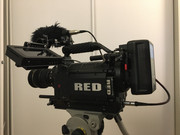-
Posts
1,156 -
Joined
-
Last visited
Content Type
Profiles
Forums
Articles
Posts posted by QuickHitRecord
-
-
Tony/Redstan
In: Cameras
If I'm not mistaken this is an article about Tony, who goes by Redstan on this forum: https://www.dailymail.co.uk/news/article-9244525/Grant-Shapps-reveals-89-year-old-father-fighting-life-Covid-ward.html
I really hope he pulls through.
-
-
I loved the idea of this competition. Wish I'd been able to participate but I was in the process of buying a home. I hope there's another one soon.
In a similar vein, I've just launched a new group on Facebook called Junk Camera Cinematography with the following thesis:
QuoteLow resolution? Compression artifacts? Clipped highlights? One person's image quality nightmare is another person's sought-after look.
This group is for filmmakers of all levels and backgrounds. Whether you're someone who enjoys the challenge of trying to shoot something with less than adequate tools, or you just like the lo-fi texture of older point-and-shoots, first generation smartphones, tape-based camcorders, or industrial/security cameras, this group embraces the cameras that serious filmmakers would NEVER use...
Or would they?
Spend as little as possible or use what you already have. Learn the quirks, make something interesting, and enjoy the creativity that comes with limitations.
I'm hoping that this group can be the antidote for those that feel like there's too much emphasis on new and better gear. It would be great to see some of you in there.
-
27 minutes ago, BTM_Pix said:
Yes and then it stores them in its database for recall as and when you need them.
When the unit is powered on, does it automatically load the last lens profile? Or does it need to be selected from a list?
-
There's a thread over on DVXuser: http://www.dvxuser.com/V6/showthread.php?356042-The-Hunt-(F3-still-delivering-the-goods)
-
4 hours ago, fuzzynormal said:
I mean, this looks pretty good to my eye. Certainly as good or better than most of the current crop of mirrorless cameras. Plenty of IQ there to tell a story. I'm shocked by how well the auto WB works. Thanks for sharing.
-
On 8/2/2020 at 9:49 AM, fuzzynormal said:
I can upload a montage of my camera test footage from when I bought my EM10III if anyone is curious.
I'd be interested in this. I bought an EM10iii last year for a pittance because I liked the idea of an inexpensive camera that could shoot decent, stabilized 4K through my Kern Switars but I haven't had much of a chance to shoot with it. I finally put it through its paces on the stills side this weekend (photos here). Hoping to capture some video soon.
-
- mercer, Tim Sewell, BenEricson and 1 other
-
 4
4
-
This thread is fascinating.
If anyone is running a recent version of the hack, what is the state of live view when recording while cropped in 3x (for C-mount lens shooting)? Is it smooth, or choppy? If it's choppy, can live view be improved by shooting without raw, but rather than high-bitrate hack (if capturing the 3x crop is even available in that mode)?
I am currently weighing the pros and cons of picking up an EOS-M (shoot in 3x crop mode with ML), an M50 (cropped 4K + 1080P crop), or a Pentax Q (probably not) for playing around with some old 16mm film lenses. Just making sure that I have all the facts. -
-
-
My friend dropped by this afternoon with his new a7Rii, so we did a quick test against my 5Diii (Magic Lantern Raw) which seems relevant to this discussion:
PW: shootout
Just as when the a7S came out, I am still happy with the image (and pleasing skintones) that I can get from my 5D3.
For those of you who take issue with my methodology, please feel free to post your own tests.
-
-
Regarding noise between the Canon C100 and the 5D Mark III (shooting raw), I did a body-cap ISO test with both of these cameras recently, and applied the exact same curves to both (to make the noise more visible. To really see them properly, you'll want to download the originals:
-
-
Stellar work! This was the creepiest film that I have seen in a while, and I think that it would be for anyone with an imagination. Acting was great and sound design was superb. You should be very proud of this!
How did you accomplish the slow push into the tape recorder? Motorized slider?
-
I'm not sure about the Mark II, but I always use Data Import Utility to import files from my Mark I. If I don't, sometimes I will have a small interruption between longer clips that span multiple files. Data Import Utility combines these spanned clips into single files. This may have been corrected in later versions of Premiere but I still do it out of habit, and I try to avoid working with spanned files whenever possible.
-
That's really funny. Great work. Don't break it to C. Suizo but he kind of looks like Aaron Rogers.
-
ML Raw Compression Ratios (5D Mark III; 1080P)
10-second clip
- Original MLV: 872MB
- RawMagic Compressed CDNG: 466MB (47% reduction)
- Davinci Resolve ProRes4444XQ: 479.2MB (45% reduction)
- Davinci Resolve ProRes4444: 316.4MB (64% reduction)
- Davinci Resolve ProResHQ: 222.9MB (74% reduction)
- Davinci Resolve ProRes422: 92.2MB (91% reduction)
-
It remains to be seen whether the BMD Video Assist supports pulldown removal like the Ninja Blade, which may be an important consideration for some (i.e. C100 shooters).
-
-
I still don't get how the stabilized frames aren't incredibly blurry but to my eye, they aren't. If this works as advertised it will be incredibly useful. I backed it.
-
I - $150 (includes shipping in the continental U.S.) - Sold.
II - $125 (includes shipping in the continental U.S.) - Sold.
III - $75 (includes shipping in the continental U.S.) - Sold.
IV - $25 (includes shipping in the continental U.S.) - Sold.
V - $25 (includes shipping in the continental U.S.) - Sold.
Thanks, everyone!
-
Update:
I - $150 (includes shipping in the continental U.S.) - Sold.
II - $125 (includes shipping in the continental U.S.)
III - $75 (includes shipping in the continental U.S.) - Sold.
IV - $25 (includes shipping in the continental U.S.) - Sold.
V - $25 (includes shipping in the continental U.S.) - Sold.
Only one left, and it's a good one!





Tony/Redstan
In: Cameras
Posted
Ah, my mistake. There was a guy who went by 'Tony' back when this forum began. He knew more about anamorphic lenses than anyone. He turned me on to Redstan/Alan's clamps and I guess I always thought they were the same person. Tony was a great resource to us all. This still might be him; I suspect that it is. And even if it's not, I hope he beats this thing.
Wish I could change the topic name but it looks like I can't.